The Meizu PRO 5 Review
by Matt Humrick on June 24, 2016 8:00 AM EST- Posted in
- Smartphones
- Exynos
- Mobile
- Meizu
- Exynos 7420
GPU Performance
Meizu’s PRO 5 uses a Mali-T760MP8 GPU with a maximum frequency of 772MHz for ALU-heavy workloads. Based on ARM’s Midgard architecture, the Mali-T760 is capable of outperforming Qualcomm’s previous generation Adreno 400 series GPUs at vertex processing, but falls behind in pixel processing.

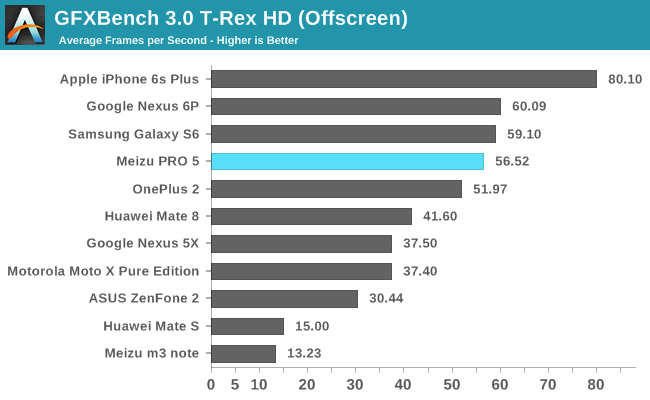
To better understand how the PRO 5 performs across a wide variety of games, we will start by looking at the OpenGL ES 2.0-based T-Rex game simulation. Because of its 1080p display, it has fewer pixels to process than the 1440p Galaxy S6, leading to better onscreen performance. Peak offscreen performance is also good, comparable to the Nexus 6P and its Adreno 430 GPU.
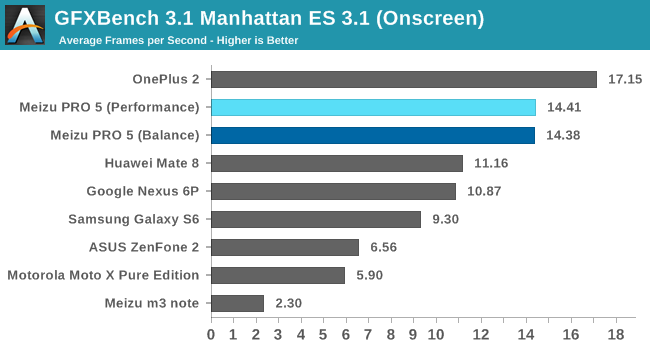
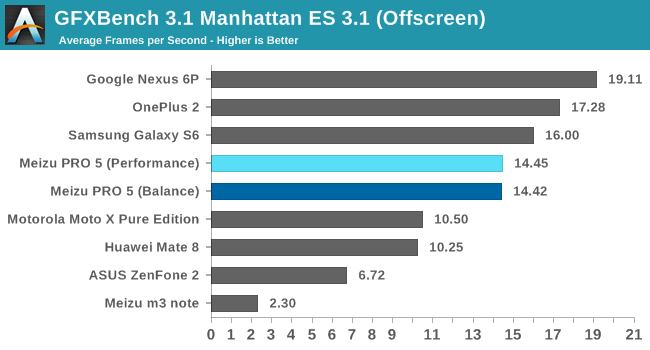
The GFXBench 4.0 Car Chase game simulation, which uses OpenGL ES 3.1 plus Android Extension Pack (AEP) features, is part of our normal test suite; however, the PRO 5 does not support hardware tessellation and is not able to run this test, so instead we’ll fall back to using GFXBench Manhattan 3.1, which still uses OpenGL ES 3.1 but does not use any AEP features.
Starting off, the PRO 5’s results are the same for both the Performance and Balance power modes. While the different modes will have some effect on performance for games that are more CPU bound, this test is entirely GPU limited, and because the PRO 5’s power modes do not affect GPU frequency, they have no impact in this test.
In the offscreen test, the PRO 5 is about 38% faster than the Moto X Pure Edition (Adreno 418) and the Mate 8, which uses the newer Mali-T880 GPU. While the Mali-T880 includes three ALU units per core versus two ALUs per core for the Mali-T760, the Mate 8 uses only four cores where the PRO 5 uses eight. After accounting for the difference in GPU clock frequency, this gives the PRO 5 124 GFLOPS of FP32 throughput versus 108 GFLOPS for the Mate 8. And because the PRO 5 has twice as many cores as the Mate 8, it can process twice as many texels/pixels per cycle too. This also applies to Huawei’s P9, whose Kirin 955 SoC uses the same Mali-T880MP4 GPU.
In the older GFXBench T-Rex test, the PRO 5’s performance was similar to the OnePlus 2 and Nexus 6P, which both use Qualcomm’s previous generation Adreno 430 GPU. This test, however, includes many more pixel effects, which take advantage of Adreno’s superior ALU performance, giving the Nexus 6P a 32% advantage over the PRO 5. While not shown in the charts above, phones such as the LG G5, which use the latest Snapdragon 820 SoC and its Adreno 530 GPU, are about twice as fast as the PRO 5 in this test.
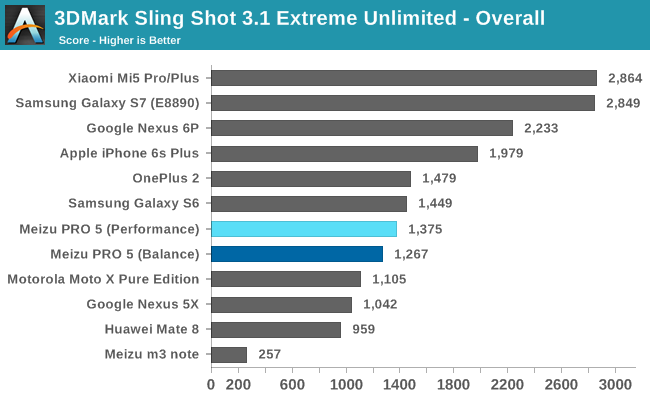
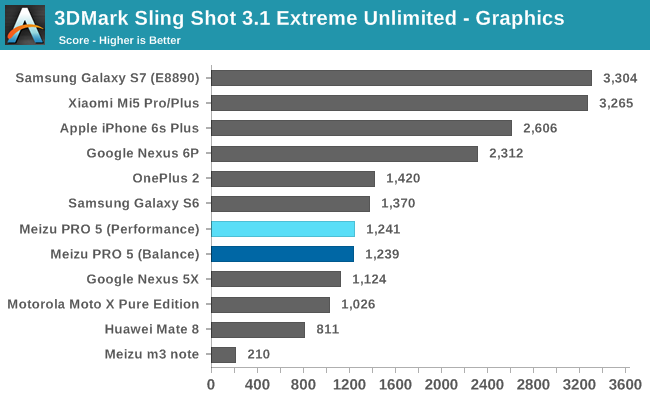
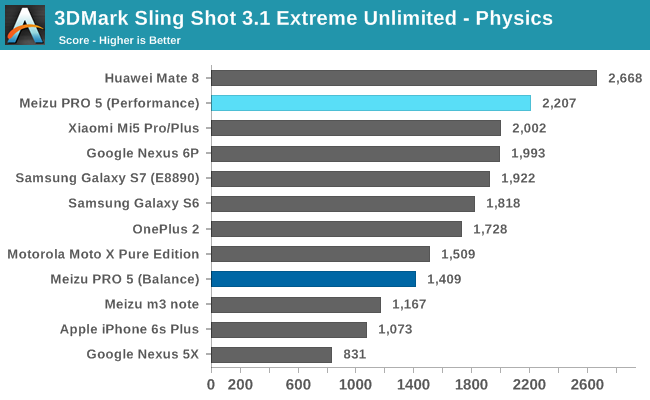
3DMark Sling Shot Extreme is another OpenGL ES 3.1 game simulation test that renders offscreen at a higher 1440p resolution than our other tests (the Physics test renders at 720p) and includes both GPU and CPU elements. Zeroing in on the graphics score, we see the PRO 5 outperform the phones using Adreno 418 and Mali-T880MP4 GPUs once again. The Nexus 6P and its Adreno 430 is 86% faster, however. The Xiaomi Mi5 (Adreno 530) and Galaxy S7 (Mali-T880MP12) perform about the same in this test with peak performance 2.66x higher than the PRO 5.
The Physics test measures CPU and memory performance by running an open source physics simulator. The PRO 5 and its Exynos 7420 SoC perform quite well, outperforming the newer Exynos 8890 and Snapdragon 820 SoCs in the Galaxy S7 and Xiaomi Mi5, respectively. Only the Mate 8’s Kirin 950 performs better. Because this is primarily a CPU test, we see a significant difference in performance between the PRO 5’s Performance and Balance modes, with the former showing a 57% advantage.
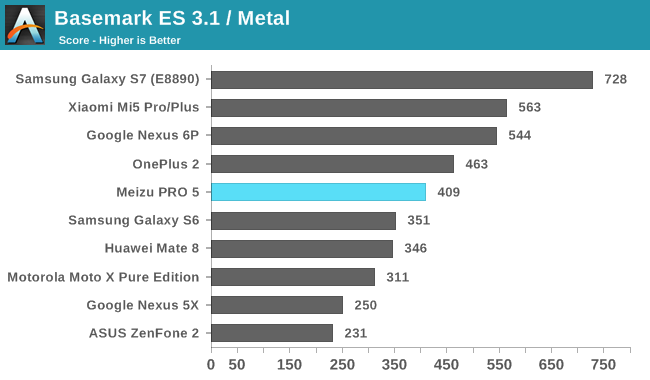
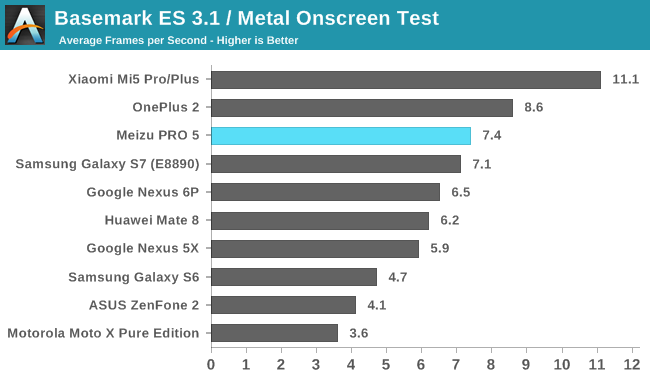
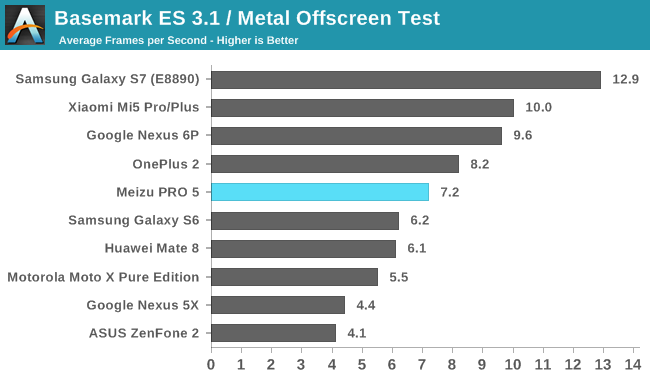
The previous performance trends hold true in Basemark ES 3.1. The Galaxy S7 at the top of the offscreen chart uses a Mali-T880MP12 GPU running at up to 650MHz. This gives it a peak, theoretical FP32 throughput of 234 GFLOPS, more than twice the Mate 8’s 108 GFLOPS and about 1.9x the PRO 5’s 124 GFLOPS, which is very close to the overall performance difference between the PRO 5 and Galaxy S7 (Exynos 8890).
The Meizu PRO 5 is certainly capable of playing modern games as long as they do not require hardware tessellation—its graphics driver currently does not support this feature. It cannot match the peak performance of the latest SoCs, but that level of performance is still overkill for the majority of games currently available. Its 1080p display, which is a negative mark overall, at least helps improve onscreen graphics performance.










80 Comments
View All Comments
Azurael - Friday, June 24, 2016 - link
"The other four phones in this roundup all have OIS and lower resolution sensors. The Mate 8 uses a 16MP Sony IMX298 Exmor RS sensor, while the iPhone 6s Plus, Nexus 6P, and Galaxy S7 all use different 12MP Sony sensors."I had to keep going over that that to make sure I wasn't misreading. I'm fairly certain the Nexus 6P doesn't have OIS...
Matt Humrick - Friday, June 24, 2016 - link
You're right. The Nexus 6P does not have OIS. I've updated the paragraph in the review.Spectrophobic - Saturday, June 25, 2016 - link
I almost thought Anandtech will finally include audio measurements on their phone reviews...Not really a fan of subjectively describing the sound of DACs and amps.
Impulses - Saturday, June 25, 2016 - link
There's a place for both IMO, numbers will never tell the whole story when it comes to audio gear, at least not until we get a lot better at measuring things AND interpreting measurements. Review sites like Innerfidelity have proven this time and again IMO...FWIW AT did include audio measurements for a brief stint when they had some loaner gear, but they don't have access to it anymore and even if they did not every smartphone reviewer would... It's definitely something I'd love to see but the logistics seem tough to figure out.
paradox_cat - Saturday, June 25, 2016 - link
can we please have a HTC 10 review? I'd be interested particularly to see how the sound quality on that compares to this Meizu Pro 5Badelhas - Saturday, June 25, 2016 - link
I would love to read AnandTechs detailed and rigorous full review of the HTC 10 as well but I still like to see these Chinese smartphones reviews as well. Just because I can't buy them except if I import them dosent mean that are a very important part of the competitionBMNify - Saturday, June 25, 2016 - link
Thanks for the review Matt, waiting for Xiaomi Redmi Note 3 and and Mi5. Also try to get the samples for LeEco Le Max2 and LeEco Le2.We are getting all these interesting phones here in India at awesome prices and need a good English review site and you already know you have a sizable Indian readership. Besides, These companies are launching in new markets every few months, so the readership for these devices will only increase in the future.
Valantar - Saturday, June 25, 2016 - link
Another more or less baffling phone review from AnandTech. Not that it isn't slightly interesting to read about uncommon devices and new configurations of known hardware, but given that AT is still missing reviews of all current high end phones save the G5 and the latest iPhone, this is an odd one.Especially given that this device - as stated in the review - won't be very relevant outside of China due to lack of LTE support, this makes me wonder if AT is under some sort of pressure to grow their reader base in China/eastern Asia.
Sure, S7 reviews are a dime a dozen, but none with the technical knowledge and depth of AT reviews. I also get that most AT editors work part time alongside other, time-consuming engagements (like studies), but that's not really an excuse for ever-increasing lateness. If your current editors are overworked, hire more.
m0rdy - Saturday, June 25, 2016 - link
I really don't mind that anandtech's reviews are late, because they're more in depth than any other reviews. Display and colors are SO important to a smartphone, but NO ONE ELSE seems to recognise it and test it as well as Anandtech (not even the manufacturers) ! That's what keeps me coming here. I only wish that the breadth of reviews were greater (i.e. more smartphones)fuicharles - Sunday, June 26, 2016 - link
I also don't mind that anadtech review being late, given it is more in depth, but please don't be too late.